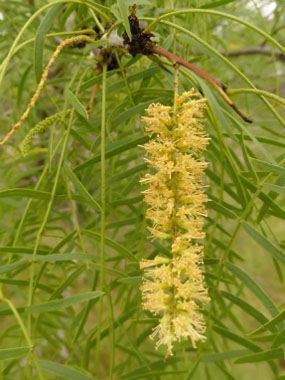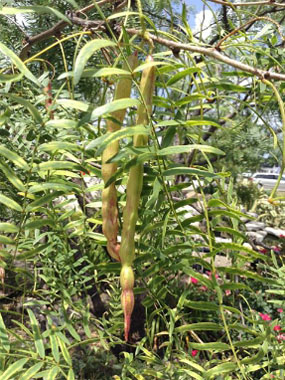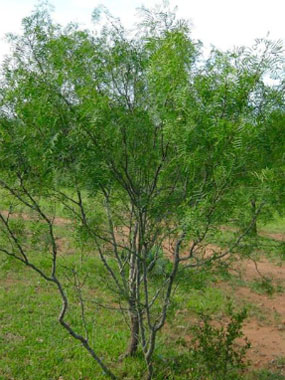







To support our efforts please browse our store (books with medicinal info, etc.).
Honey mesquite is a deciduous, small tree that can reach heights of 9 metres (30'). The crown spreads a distance equal or more to the height. It is a member of the legume family of plants which includes peanuts, alfalfa, clover, and beans. Perfectly adapted for its dry environment, the mesquite is a hardy tree located more in the southern areas of the U.S. The word mesquite is a Spanish adaptation of the Aztec name mizquitl. The Apache and Isleta once applied the juice from the leaves of honey mesquite to eyelids as a treatment for irritation. The Comanche chewed the leaves and swallowed the juice for an antacid. The Navajo used the wood from honey mesquite to construct bows.
Trunk/Bark
Honey mesquite has a showy trunk; thorns are present on the trunk as well as the branches. They can have a multiple trunk structure and tend to have a grayish sculptural trunk. Typically, a single-trunked tree that was cut down will soon become multi-trunked.
Branches/Twigs
Twigs are armed with sharp thorns up to 10cm (2”) long especially on young plants. Branches tend to droop as the tree grows creating a canopy.
Height
The honey mesquite tree can reach heights of up to 9 metres (30').
Leaves/Needles
The leaves are alternate, bipinnate, and have petioles. There are usually one paired division (pinnae) per leaf and 6 to 15 leaflets per pinna. The leaflets are 1 to 6 cm (up to 3”) long and smooth.
Flowers
Yellow flowers are in axillary spikes that are 7 to 9 cm long. The calyx has a shallow, cup-like shape. Each flower has 10 stamens and white woolly ovaries.
Fruit
The legumes are straight and nearly as thick as they are broad, 7 to 20 cm (3 to 8”) long. The legumes are reddish-brown and constricted between seeds. The seeds are 6 to 6.5 mm long and brownish in colour.
Habitat
Honey mesquite is native to North America, in northern Mexico and the southern USA from the Pacific coast to the Gulf of Mexico. Although very widely introduced around the world, honey mesquite is quite common in Australia and southern Africa. It occurs in parts of southern Europe, the Middle East, parts of Asia and in Cuba.
Edible Parts
The seedpods and seeds are cooked, ground, water added, then allowed to ferment and used as a beverage. Immature seedpods are cooked and the juice squeezed out then consumed like milk as a summer beverage. Mature pods can be eaten without any processing. The seeds have been ground into a powder and used to make bread or pancakes. The roots have been used to flavour drinks. Flowers are used to make a tea. Mark at Foraging Texas warns people, up to 20 percent of mesquite pods are infected with very dangerous aflatoxin-producing fungus. Only pick pods that are still on the tree and have not been attacked by boring-beetles.
Other Name
Glandular mesquite.
Recipes
A special thank you to Mark Merriwether of ForagingTexas (https://www.foragingtexas.com/) for providing the images to help make the honey mesquite possible on our website.
Winter Survival Food Handbook

PDF Plant Magazines
Types of Wild Food
Geographic Zones Seasons
Disclaimer
EdibleWildFood.com is informational in nature. While we strive to be 100% accurate, it is solely up to the reader to ensure proper plant identification. Some wild plants are poisonous or can have serious adverse health effects.
We are not health professionals, medical doctors, nor are we nutritionists. It is up to the reader to verify nutritional information and health benefits with qualified professionals for all edible plants listed in this web site. Please click here for more information.
Why Edible Wild Food?
- Food costs are rising
- Free, wild food is readily abundant
- Wild food adds nutrition to your diet
- Wild food can help treat various medical conditions





